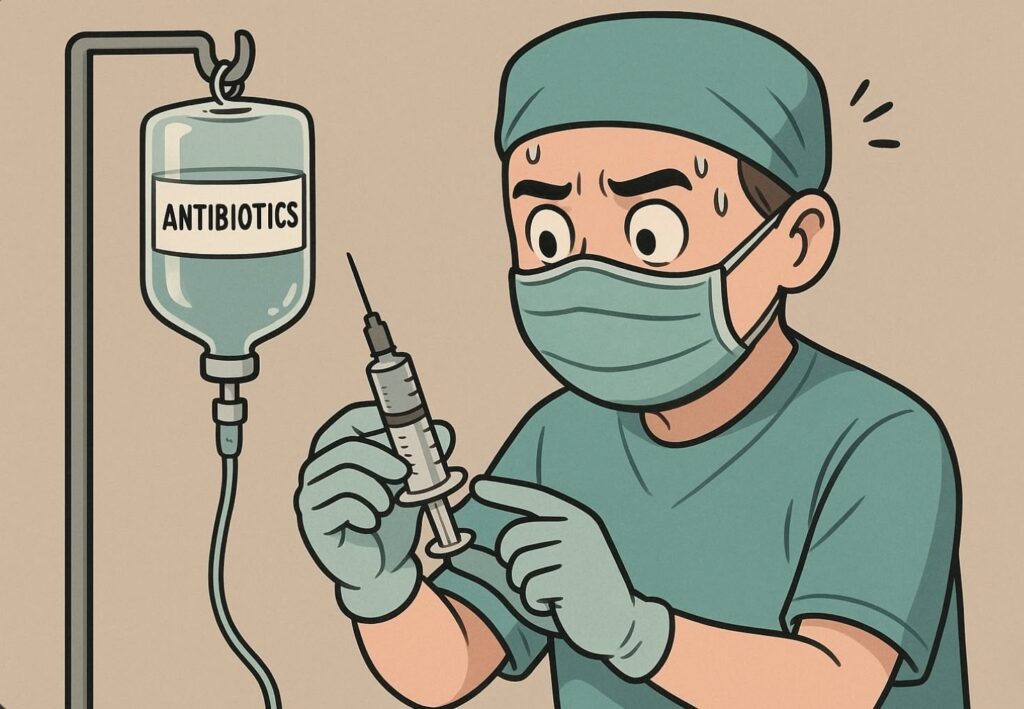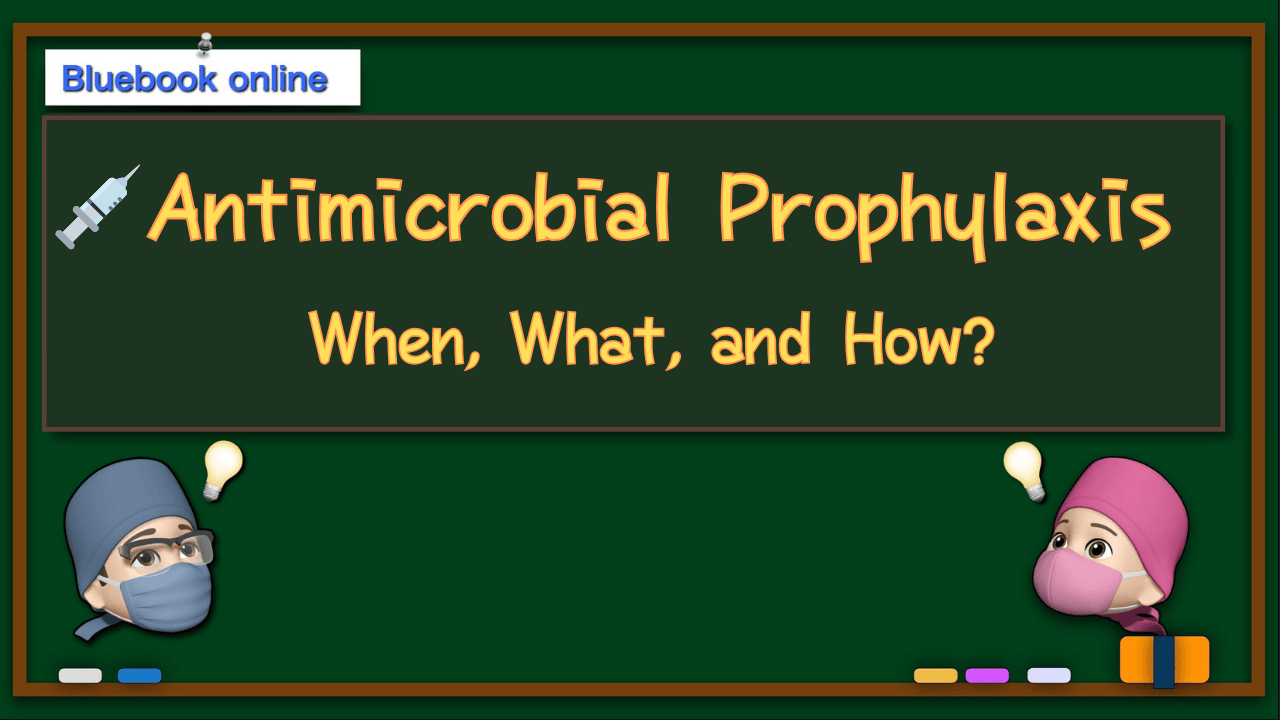👉👉 🇺🇸 All Posts 🇬🇧 / 🇯🇵 記事一覧 🇯🇵 👈👈
♦️ Introduction
This time, let’s focus on perioperative antibiotic prophylaxis — a key measure to prevent surgical site infections (SSI).
- “Prophylactic antibiotics for surgery? Just give cefazolin, right?”
- “Maybe I’ll continue them for a few days after surgery, just in case…” 🤔
Have you ever thought like this? In the past, antibiotics were sometimes given without strict evidence, and postoperative courses were prolonged at the discretion of the attending surgeon.
But with the global spread of antimicrobial resistance, this practice had to change. Nowadays, prophylactic antibiotic use is even included in the WHO Surgical Safety Checklist, and multiple evidence-based guidelines are available 😊.
- CDC Guideline for Prevention of Surgical Site Infection (2017)
- ASHP Therapeutic Guidelines on Antimicrobial Prophylaxis in Surgery (2013)
- SHEA/IDSA Practice Recommendation: Strategies to Prevent SSI in Acute Care Hospitals (2022)
- NICE Guideline: Surgical Site Infections: Prevention and Treatment (2019)
The important points — both in exams and in daily clinical practice — are:
- Which antibiotic and at what dose?
- When should it be administered preoperatively?
- When to redose intraoperatively?
- How long to continue postoperatively?
Let’s take a closer look.

♦️ Which Antibiotic and How Much?
For prophylaxis, the target is not an established infection but the likely organisms at the surgical site.
🔷 Cefazolin is the most commonly used prophylactic antibiotic worldwide.
- It covers common SSI pathogens such as Staphylococcus aureus and coagulase-negative staphylococci.
- For gastrointestinal surgery, additional coverage against Gram-negative rods and anaerobes is required. Options include cefoxitin, cefotetan, or ceftriaxone plus metronidazole.
- For patients with β-lactam allergy, clindamycin or vancomycin can be used. Vancomycin should be reserved for MRSA carriers or when institutional MRSA prevalence is high.
🔷 Dosing
- Cefazolin: 2 g IV for patients <120 kg, 3 g IV for patients ≥120 kg.
- In obese patients, dose adjustment is important.
- In renal impairment, extend the dosing interval rather than reducing the dose.
♦️ When Should It Be Given?
🔷 Antibiotics must be completed before incision!
- Ideally, administer within 60 minutes before incision.
- For agents requiring longer infusion times (e.g., vancomycin, fluoroquinolones), start 120 minutes before.
- Vancomycin should be infused over at least 1 hour to avoid hypotension (“Vancomycin flushing syndrome (VFS)”).
♦️ When to Redose Intraoperatively?
🔷 At about twice the drug’s half-life.
- For cefazolin (half-life ~2 hours), redose at 3–4 hours after the initial dose.
- Some institutions simplify protocols by setting a standard redosing interval (e.g., every 3 hours).
- Furthermore, since vancomycin has a relatively long half-life of about 4–6 hours, redosing is generally unnecessary during routine surgeries. If redosing is required, care must be taken to avoid rapid infusion — preferably using an infusion pump, or at least closely monitoring the rate to prevent inadvertent rapid administration.
- At present, the evidence supporting reduced SSI rates through intraoperative redosing is limited. However, in cases of prolonged surgery or massive blood loss, redosing according to institutional protocols is recommended. Importantly, the timing of redosing is usually counted from the start of the initial infusion.
🔷 Massive blood loss🩸
- If blood loss exceeds ~1500 mL, redose regardless of elapsed time.
🔷 Renal impairment
- Extend dosing intervals appropriately.
🔷 Obese patients
- ASHP guidelines recommend 3 g cefazolin for patients ≥120 kg.
♦️ How Long Postoperatively?
🔷 Avoid prolonged administration!
- Most guidelines recommend discontinuation within 24 hours.
- For clean procedures, a single pre-incision dose is often sufficient.
- Continuing antibiotics for several days postoperatively has no proven benefit and only promotes resistance.
Summary: Follow Your Local Protocol
Despite clear guidelines, surveys show that inappropriate use of prophylactic antibiotics is still common.
🤔 “What are the rules in my hospital?”
Always check your institutional perioperative infection prevention protocol — antibiotic selection, timing, redosing, and duration should be clearly defined.
- Administer prophylactic antibiotics within 60 minutes before incision (120 minutes for vancomycin/fluoroquinolones).
- Cefazolin is first-line for most surgeries; add anaerobic coverage for GI cases.
- Adjust doses for obese patients (≥120 kg → 3 g cefazolin).
- Redose if surgery is prolonged (>2 half-lives) or with major blood loss (>1500 mL).
- Discontinue within 24 hours postoperatively (shorter for clean procedures).
- Use clindamycin or vancomycin for β-lactam–allergic patients; reserve vancomycin for MRSA carriers/high-risk settings.
- Ultimately, always follow your institution’s protocol.
📚 References & Further reading
- CDC Guideline for Prevention of Surgical Site Infection (2017)
- ríos-Torres SI, et al. Centers for Disease Control and Prevention Guideline for the Prevention of Surgical Site Infection, 2017. JAMA Surg. 2017;152(8):784-791.👉 CDC SSI Guideline
- ASHP Therapeutic Guidelines on Antimicrobial Prophylaxis in Surgery (2013)
- Bratzler DW, et al. Clinical Practice Guidelines for Antimicrobial Prophylaxis in Surgery. Am J Health Syst Pharm. 2013;70(3):195-283.👉 ASHP Guideline
- SHEA/IDSA Strategies to prevent surgical site infections in acute-care hospitals: 2022 Update
- NICE Guideline: Surgical Site Infections: Prevention and Treatment (2019)

コメントを投稿するにはログインしてください。